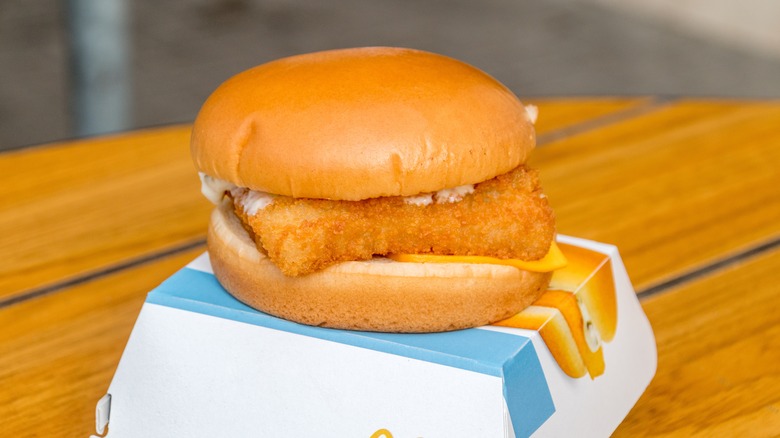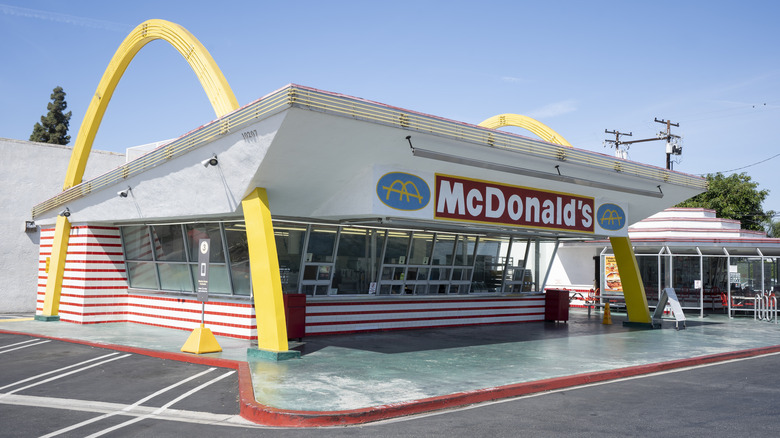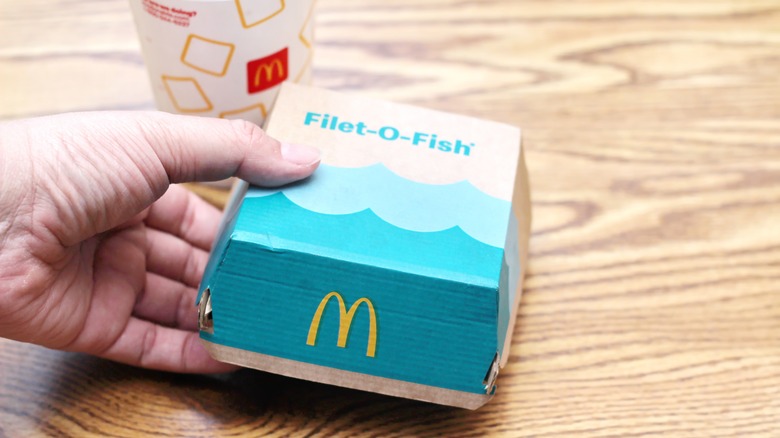The Documentary-Worthy History Of McDonald's Filet-O-Fish
The McDonald's menu is a thing of beauty. Like the ripples of the ocean tide lapping upon the shore, it is ever-changing, yet fixed in its ebb and flow. Menu items come and go, and who knows when (or if) that mythical McRib will return. But there are some McDonald's items that have earned their place on the permanent menu. One of the most delicious additions is the Filet-O-Fish, which — despite its humble, simple recipe — has managed to become a mainstay on the McDonald's menu.
Consisting of a breaded fish filet sandwiched between a bun, topped only with a slice of American cheese and tartar sauce, the Filet-O-Fish doesn't have the height or saucy status of the Big Mac, nor the heft of the Quarter Pounder with Cheese. However, what the Filet-O-Fish does have is a backstory worthy of its own documentary. First added to the McDonald's menu in 1965, the sandwich displays the ingenuity of one McDonald's franchise owner named Lou Groen, who saved his locations from closing and changed the fast food chain forever.
The story of this seafood sandwich does not begin on the seashore, as one might expect, but in the very Midwestern suburbs of Cincinnati, Ohio in 1961. The early years of the restaurant were tough, and Groen's children often had to work for free at McDonald's for the business to stay afloat.
A big fish in a small pond
Now, it may seem unlikely that such a fast food behemoth would have a difficult time staying open. However, it is important to note that McDonald's only had about 200 locations in 1960, far behind its current ubiquity (there are now almost 42,000 locations worldwide, according to research from Statista). When Lou Groen opened his location in Ohio, McDonald's was not yet the mainstay that it is now, so he struggled to keep the doors open.
One particular (and unique) challenge to Groen's franchise was of a religious nature. Groen once told the Chicago Tribune that at the time, his restaurant was serving a community that was 87% Catholic. Since it was prohibited by the Catholic doctrine to eat meat on Fridays throughout the year, Groen's business was often barely able to scrape up $75 in business on Fridays.
But instead of calling it quits on his burger venture, Groen looked to a fellow fast food restaurant, Big Boy, which was serving fish sandwiches to accommodate the local Catholic population. Seeing its success, Groen decided to cook up his own fish sandwich to keep his location afloat. However, it wasn't exactly smooth sailing to get Groen's innovation on the McDonald's menu. First, he would have to go up against McDonald's founder and legendary businessman, Ray Kroc.
Fish vs. pineapple
In the early 1960s, Lou Groen went to the McDonald's corporate headquarters in Chicago, where he presented his fish sandwich to Ray Kroc. However, Kroc was not enthused with Groen's idea. This is most likely because Kroc had his own idea for a Friday-friendly burger, but he wasn't looking to the seas for a meat alternative. Instead, he opted for fruit. Kroc's Hula Burger, which consisted of a grilled pineapple ring and a slice of cheese, was supposed to fill in the gaps in business on Fridays left by the meatless Catholic crowd.
Rather than shutting down Groen's idea completely, it was decided that the two sandwiches would appear on the menu for Good Friday in 1962. Whichever item sold the most would be the winner — but it wasn't even close. McDonald's reported that the Filet-O-Fish sold 350 units while the Hula Burger sold a paltry 6 units. So, the Hula Burger quickly became a thing of the past, and by 1965, the Filet-O-Fish became the first addition to the permanent McDonald's menu, where it still resides.
The iconic fish sandwich is still a hit with Catholic fans of McDonald's. Though the Catholic church stopped mandating meatless Fridays year-round in 1966, Catholics are still largely meatless on Fridays during the Lenten season. You can clearly see this in Filet-O-Fish sales during Lent, as about a quarter of all Filet-O-Fish sandwiches sold each year are purchased during the 40 day period.


